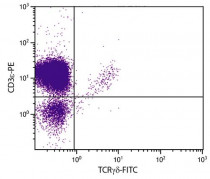ARG20990
anti-TCR gamma + TCR delta antibody [UC7-13D5] (FITC)
anti-TCR gamma + TCR delta antibody [UC7-13D5] (FITC) for Depletion,Flow cytometry and Mouse
Overview
| Product Description | FITC-conjugated Hamster Monoclonal antibody [UC7-13D5] recognizes TCR gamma + TCR delta |
|---|---|
| Tested Reactivity | Ms |
| Tested Application | Depletion, FACS |
| Specificity | Mouse TCRγδ. The clone UC7-13D5 is specific for the γδ heterodimer and plate-bound UC7-13D5 activates γδ TCR-bearing cells. This antibody does not react with αβ TCR-expressing T cells. |
| Host | Hamster |
| Clonality | Monoclonal |
| Clone | UC7-13D5 |
| Isotype | IgG3 |
| Target Name | TCR gamma + TCR delta |
| Antigen Species | Mouse |
| Immunogen | Mouse T cell clone G8 |
| Conjugation | FITC |
| Alternate Names | TCR gamma: TCRG TCR delta: TCRD; TCRDV1 |
Application Instructions
| Application Suggestion |
|
||||||
|---|---|---|---|---|---|---|---|
| Application Note | * The dilutions indicate recommended starting dilutions and the optimal dilutions or concentrations should be determined by the scientist. |
Properties
| Form | Liquid |
|---|---|
| Buffer | PBS and 0.1% Sodium azide. |
| Preservative | 0.1% Sodium azide |
| Concentration | 0.5 mg/ml |
| Storage Instruction | Aliquot and store in the dark at 2-8°C. Keep protected from prolonged exposure to light. Avoid repeated freeze/thaw cycles. Suggest spin the vial prior to opening. The antibody solution should be gently mixed before use. |
| Note | For laboratory research only, not for drug, diagnostic or other use. |
Bioinformation
| Gene Symbol | TRG; TRD |
|---|---|
| Gene Full Name | T cell receptor gamma locus; T cell receptor delta locus |
| Background | TCR gamma: T cell receptors recognize foreign antigens which have been processed as small peptides and bound to major histocompatibility complex (MHC) molecules at the surface of antigen presenting cells (APC). Each T cell receptor is a dimer consisting of one alpha and one beta chain or one delta and one gamma chain. In a single cell, the T cell receptor loci are rearranged and expressed in the order delta, gamma, beta, and alpha. If both delta and gamma rearrangements produce functional chains, the cell expresses delta and gamma. If not, the cell proceeds to rearrange the beta and alpha loci. This region represents the germline organization of the T cell receptor gamma locus. The gamma locus includes V (variable), J (joining), and C (constant) segments. During T cell development, the gamma chain is synthesized by a recombination event at the DNA level joining a V segment with a J segment; the C segment is later joined by splicing at the RNA level. Recombination of many different V segments with several J segments provides a wide range of antigen recognition. Additional diversity is attained by junctional diversity, resulting from the random addition of nucleotides by terminal deoxynucleotidyltransferase. Several V segments of the gamma locus are known to be incapable of encoding a protein and are considered pseudogenes. Somatic rearrangement of the gamma locus has been observed in T cells derived from patients with T cell leukemia and ataxia telangiectasia. [provided by RefSeq, Jul 2008] |
| Highlight | Related products: TCR antibodies; TCR Duos / Panels; Anti-Hamster IgG secondary antibodies; Related news: New antibody panels and duos for Tumor immune microenvironment |
| Calculated MW | 19 kDa |
Images (1) Click the Picture to Zoom In
-
ARG20990 anti-TCR gamma + TCR delta antibody [UC7-13D5] (FITC) FACS image
Flow Cytometry: CD-1 Mouse mesenteric lymph node cells stained with ARG20990 anti-TCR gamma + TCR delta antibody [UC7-13D5] (FITC) and ARG20819 anti-CD3e antibody [C363.29B] (PE).






